Comparison of Indian Hijras and North American Two Spirit People
VerifiedAdded on 2023/06/03
|8
|2034
|413
AI Summary
This article compares the social roles played by Indian Hijras and North American Two Spirit People. It highlights the similarities and differences between the two groups. The article discusses the role of these groups as mediators in their societies, their beliefs and practices, and the impact of colonialism on their cultures.
Contribute Materials
Your contribution can guide someone’s learning journey. Share your
documents today.

Social work/global sociology
Name
Institution
Course
Date
Name
Institution
Course
Date
Secure Best Marks with AI Grader
Need help grading? Try our AI Grader for instant feedback on your assignments.
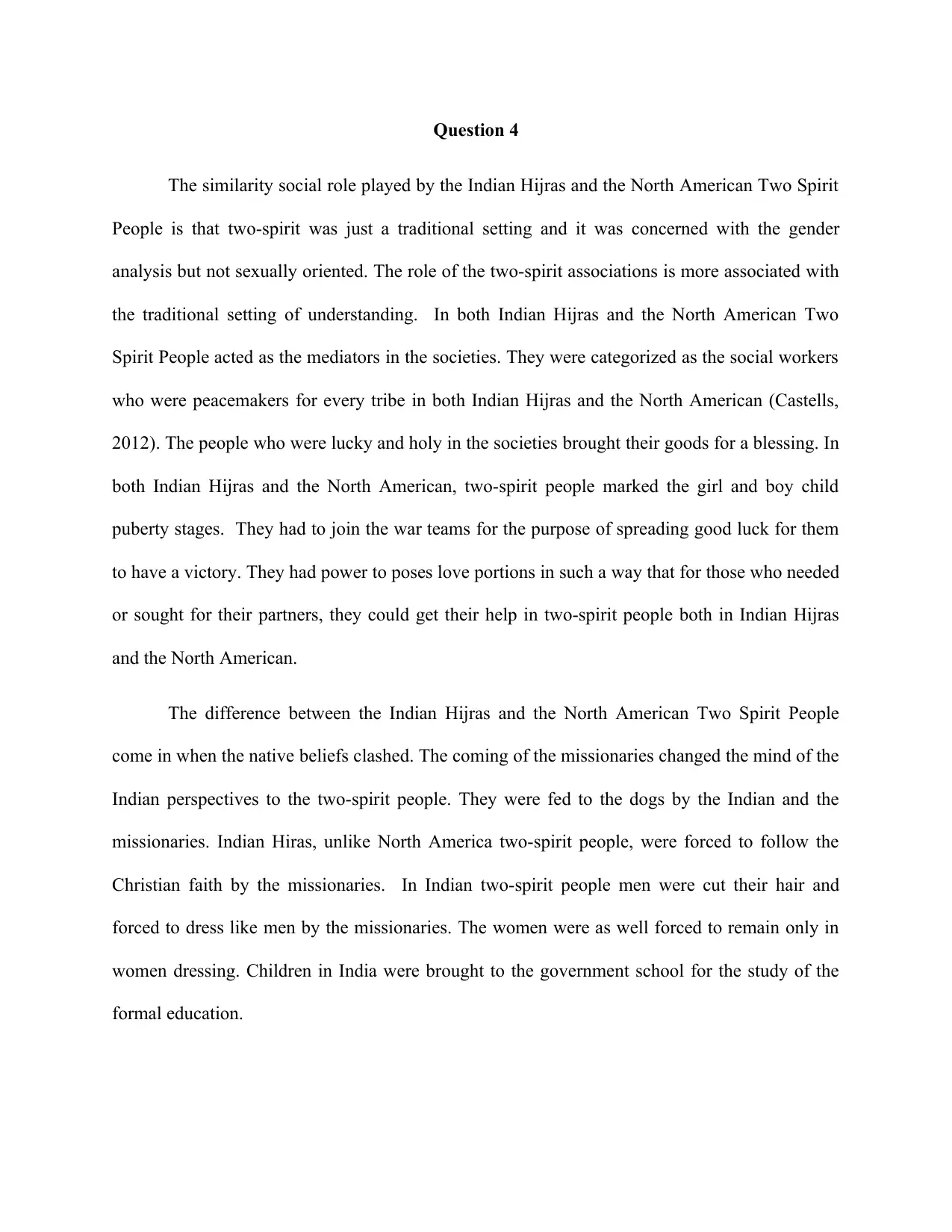
Question 4
The similarity social role played by the Indian Hijras and the North American Two Spirit
People is that two-spirit was just a traditional setting and it was concerned with the gender
analysis but not sexually oriented. The role of the two-spirit associations is more associated with
the traditional setting of understanding. In both Indian Hijras and the North American Two
Spirit People acted as the mediators in the societies. They were categorized as the social workers
who were peacemakers for every tribe in both Indian Hijras and the North American (Castells,
2012). The people who were lucky and holy in the societies brought their goods for a blessing. In
both Indian Hijras and the North American, two-spirit people marked the girl and boy child
puberty stages. They had to join the war teams for the purpose of spreading good luck for them
to have a victory. They had power to poses love portions in such a way that for those who needed
or sought for their partners, they could get their help in two-spirit people both in Indian Hijras
and the North American.
The difference between the Indian Hijras and the North American Two Spirit People
come in when the native beliefs clashed. The coming of the missionaries changed the mind of the
Indian perspectives to the two-spirit people. They were fed to the dogs by the Indian and the
missionaries. Indian Hiras, unlike North America two-spirit people, were forced to follow the
Christian faith by the missionaries. In Indian two-spirit people men were cut their hair and
forced to dress like men by the missionaries. The women were as well forced to remain only in
women dressing. Children in India were brought to the government school for the study of the
formal education.
The similarity social role played by the Indian Hijras and the North American Two Spirit
People is that two-spirit was just a traditional setting and it was concerned with the gender
analysis but not sexually oriented. The role of the two-spirit associations is more associated with
the traditional setting of understanding. In both Indian Hijras and the North American Two
Spirit People acted as the mediators in the societies. They were categorized as the social workers
who were peacemakers for every tribe in both Indian Hijras and the North American (Castells,
2012). The people who were lucky and holy in the societies brought their goods for a blessing. In
both Indian Hijras and the North American, two-spirit people marked the girl and boy child
puberty stages. They had to join the war teams for the purpose of spreading good luck for them
to have a victory. They had power to poses love portions in such a way that for those who needed
or sought for their partners, they could get their help in two-spirit people both in Indian Hijras
and the North American.
The difference between the Indian Hijras and the North American Two Spirit People
come in when the native beliefs clashed. The coming of the missionaries changed the mind of the
Indian perspectives to the two-spirit people. They were fed to the dogs by the Indian and the
missionaries. Indian Hiras, unlike North America two-spirit people, were forced to follow the
Christian faith by the missionaries. In Indian two-spirit people men were cut their hair and
forced to dress like men by the missionaries. The women were as well forced to remain only in
women dressing. Children in India were brought to the government school for the study of the
formal education.
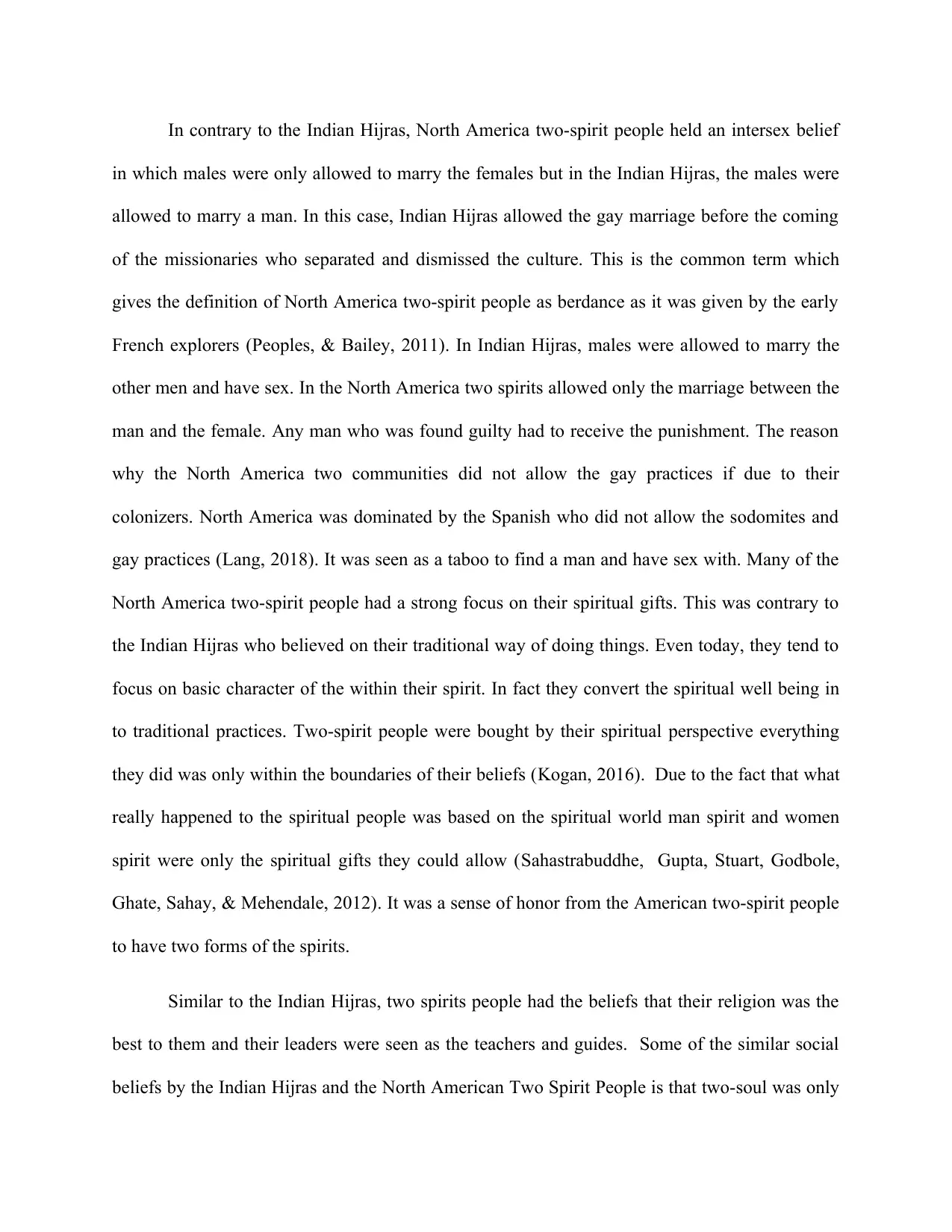
In contrary to the Indian Hijras, North America two-spirit people held an intersex belief
in which males were only allowed to marry the females but in the Indian Hijras, the males were
allowed to marry a man. In this case, Indian Hijras allowed the gay marriage before the coming
of the missionaries who separated and dismissed the culture. This is the common term which
gives the definition of North America two-spirit people as berdance as it was given by the early
French explorers (Peoples, & Bailey, 2011). In Indian Hijras, males were allowed to marry the
other men and have sex. In the North America two spirits allowed only the marriage between the
man and the female. Any man who was found guilty had to receive the punishment. The reason
why the North America two communities did not allow the gay practices if due to their
colonizers. North America was dominated by the Spanish who did not allow the sodomites and
gay practices (Lang, 2018). It was seen as a taboo to find a man and have sex with. Many of the
North America two-spirit people had a strong focus on their spiritual gifts. This was contrary to
the Indian Hijras who believed on their traditional way of doing things. Even today, they tend to
focus on basic character of the within their spirit. In fact they convert the spiritual well being in
to traditional practices. Two-spirit people were bought by their spiritual perspective everything
they did was only within the boundaries of their beliefs (Kogan, 2016). Due to the fact that what
really happened to the spiritual people was based on the spiritual world man spirit and women
spirit were only the spiritual gifts they could allow (Sahastrabuddhe, Gupta, Stuart, Godbole,
Ghate, Sahay, & Mehendale, 2012). It was a sense of honor from the American two-spirit people
to have two forms of the spirits.
Similar to the Indian Hijras, two spirits people had the beliefs that their religion was the
best to them and their leaders were seen as the teachers and guides. Some of the similar social
beliefs by the Indian Hijras and the North American Two Spirit People is that two-soul was only
in which males were only allowed to marry the females but in the Indian Hijras, the males were
allowed to marry a man. In this case, Indian Hijras allowed the gay marriage before the coming
of the missionaries who separated and dismissed the culture. This is the common term which
gives the definition of North America two-spirit people as berdance as it was given by the early
French explorers (Peoples, & Bailey, 2011). In Indian Hijras, males were allowed to marry the
other men and have sex. In the North America two spirits allowed only the marriage between the
man and the female. Any man who was found guilty had to receive the punishment. The reason
why the North America two communities did not allow the gay practices if due to their
colonizers. North America was dominated by the Spanish who did not allow the sodomites and
gay practices (Lang, 2018). It was seen as a taboo to find a man and have sex with. Many of the
North America two-spirit people had a strong focus on their spiritual gifts. This was contrary to
the Indian Hijras who believed on their traditional way of doing things. Even today, they tend to
focus on basic character of the within their spirit. In fact they convert the spiritual well being in
to traditional practices. Two-spirit people were bought by their spiritual perspective everything
they did was only within the boundaries of their beliefs (Kogan, 2016). Due to the fact that what
really happened to the spiritual people was based on the spiritual world man spirit and women
spirit were only the spiritual gifts they could allow (Sahastrabuddhe, Gupta, Stuart, Godbole,
Ghate, Sahay, & Mehendale, 2012). It was a sense of honor from the American two-spirit people
to have two forms of the spirits.
Similar to the Indian Hijras, two spirits people had the beliefs that their religion was the
best to them and their leaders were seen as the teachers and guides. Some of the similar social
beliefs by the Indian Hijras and the North American Two Spirit People is that two-soul was only
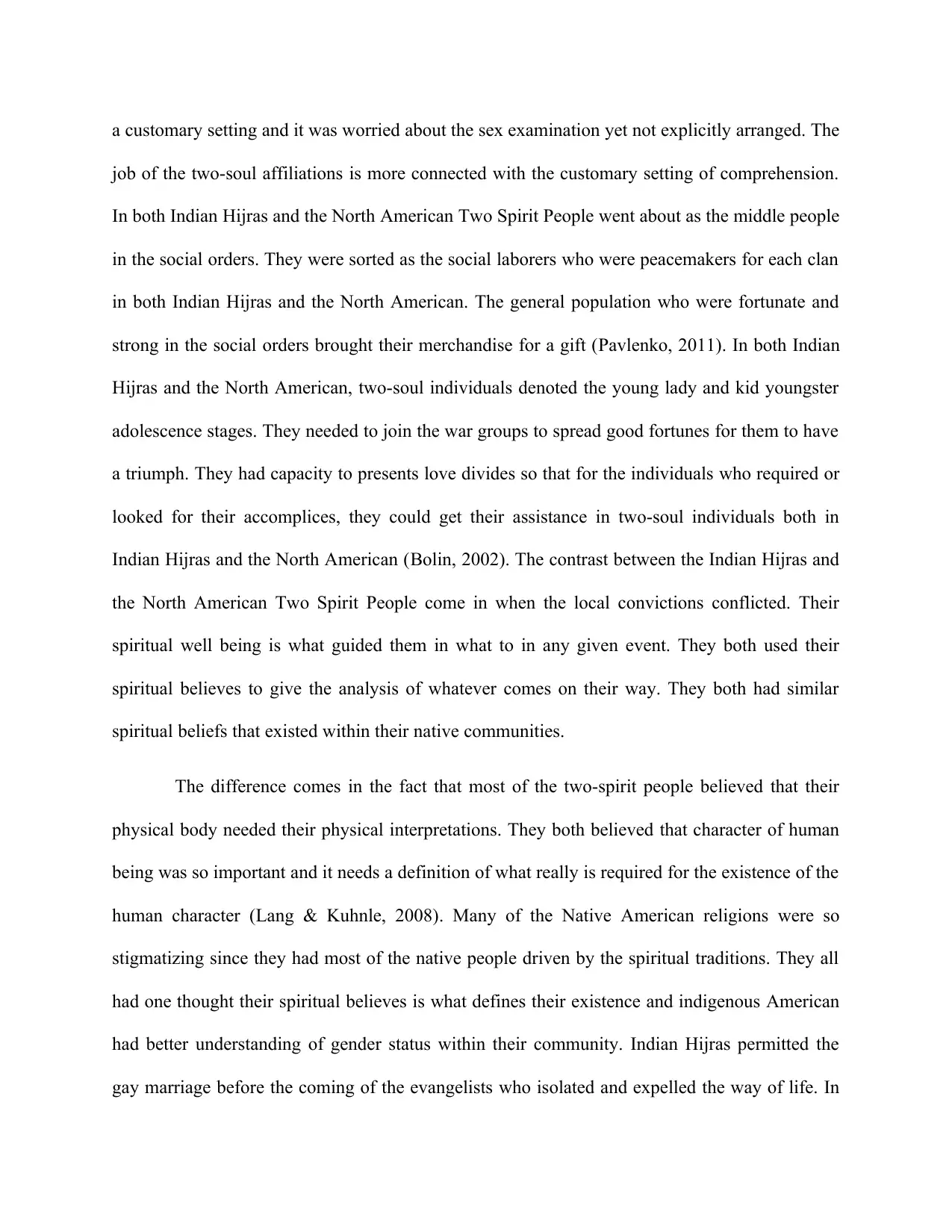
a customary setting and it was worried about the sex examination yet not explicitly arranged. The
job of the two-soul affiliations is more connected with the customary setting of comprehension.
In both Indian Hijras and the North American Two Spirit People went about as the middle people
in the social orders. They were sorted as the social laborers who were peacemakers for each clan
in both Indian Hijras and the North American. The general population who were fortunate and
strong in the social orders brought their merchandise for a gift (Pavlenko, 2011). In both Indian
Hijras and the North American, two-soul individuals denoted the young lady and kid youngster
adolescence stages. They needed to join the war groups to spread good fortunes for them to have
a triumph. They had capacity to presents love divides so that for the individuals who required or
looked for their accomplices, they could get their assistance in two-soul individuals both in
Indian Hijras and the North American (Bolin, 2002). The contrast between the Indian Hijras and
the North American Two Spirit People come in when the local convictions conflicted. Their
spiritual well being is what guided them in what to in any given event. They both used their
spiritual believes to give the analysis of whatever comes on their way. They both had similar
spiritual beliefs that existed within their native communities.
The difference comes in the fact that most of the two-spirit people believed that their
physical body needed their physical interpretations. They both believed that character of human
being was so important and it needs a definition of what really is required for the existence of the
human character (Lang & Kuhnle, 2008). Many of the Native American religions were so
stigmatizing since they had most of the native people driven by the spiritual traditions. They all
had one thought their spiritual believes is what defines their existence and indigenous American
had better understanding of gender status within their community. Indian Hijras permitted the
gay marriage before the coming of the evangelists who isolated and expelled the way of life. In
job of the two-soul affiliations is more connected with the customary setting of comprehension.
In both Indian Hijras and the North American Two Spirit People went about as the middle people
in the social orders. They were sorted as the social laborers who were peacemakers for each clan
in both Indian Hijras and the North American. The general population who were fortunate and
strong in the social orders brought their merchandise for a gift (Pavlenko, 2011). In both Indian
Hijras and the North American, two-soul individuals denoted the young lady and kid youngster
adolescence stages. They needed to join the war groups to spread good fortunes for them to have
a triumph. They had capacity to presents love divides so that for the individuals who required or
looked for their accomplices, they could get their assistance in two-soul individuals both in
Indian Hijras and the North American (Bolin, 2002). The contrast between the Indian Hijras and
the North American Two Spirit People come in when the local convictions conflicted. Their
spiritual well being is what guided them in what to in any given event. They both used their
spiritual believes to give the analysis of whatever comes on their way. They both had similar
spiritual beliefs that existed within their native communities.
The difference comes in the fact that most of the two-spirit people believed that their
physical body needed their physical interpretations. They both believed that character of human
being was so important and it needs a definition of what really is required for the existence of the
human character (Lang & Kuhnle, 2008). Many of the Native American religions were so
stigmatizing since they had most of the native people driven by the spiritual traditions. They all
had one thought their spiritual believes is what defines their existence and indigenous American
had better understanding of gender status within their community. Indian Hijras permitted the
gay marriage before the coming of the evangelists who isolated and expelled the way of life. In
Secure Best Marks with AI Grader
Need help grading? Try our AI Grader for instant feedback on your assignments.

Indian Hijras, guys were permitted to wed the other men and engage in sexual relations. In the
North America two spirits permitted just the marriage between the man and the female. Any man
who was discovered liable needed to get the discipline. The motivation behind why the North
America two networks did not permit the gay practices if because of their colonizers. North
America was dominated by the Spanish who did not permit the homosexuals and gay practices. It
was viewed as an unthinkable to discover a man and have intercourse with. A significant number
of the North America two soul individuals had a solid spotlight on their otherworldly
endowments. This was in opposition to the Indian Hijras who accepted on their customary
method for getting things done. Indeed, even today, they tend to center around fundamental
character of the inside their soul. North America was bound by their profound point of view all
that they did was just inside the limits of their convictions (Herdt, 2011). Because of the way that
what truly happened to the profound individuals depended on the otherworldly world man soul
and ladies soul were just the profound endowments they could permit. It was a feeling of respect
from the American two soul individuals to have two types of the spirits.
Like the Indian Hijras, two spirits had the convictions that their religion. A portion of the
comparable social convictions by the Indian Hijras and the North American Two Spirit People is
that two-soul was just a standard setting and it was stressed over the sex examination yet not
expressly orchestrated. The contrast between the Indian Hijras and the North American Two
Spirit People come in when the local convictions conflicted (Towle & Morgan, 2012). The
happening to the ministers changed the brain of the Indian points of view to the two-soul
individuals. They were nourished to the pooches by the Indian and the teachers. In Indian two-
soul individuals men were trimmed their hair and compelled to dress like men by the teachers.
The ladies were also compelled to stay just in ladies dressing. Kids in India were conveyed to the
North America two spirits permitted just the marriage between the man and the female. Any man
who was discovered liable needed to get the discipline. The motivation behind why the North
America two networks did not permit the gay practices if because of their colonizers. North
America was dominated by the Spanish who did not permit the homosexuals and gay practices. It
was viewed as an unthinkable to discover a man and have intercourse with. A significant number
of the North America two soul individuals had a solid spotlight on their otherworldly
endowments. This was in opposition to the Indian Hijras who accepted on their customary
method for getting things done. Indeed, even today, they tend to center around fundamental
character of the inside their soul. North America was bound by their profound point of view all
that they did was just inside the limits of their convictions (Herdt, 2011). Because of the way that
what truly happened to the profound individuals depended on the otherworldly world man soul
and ladies soul were just the profound endowments they could permit. It was a feeling of respect
from the American two soul individuals to have two types of the spirits.
Like the Indian Hijras, two spirits had the convictions that their religion. A portion of the
comparable social convictions by the Indian Hijras and the North American Two Spirit People is
that two-soul was just a standard setting and it was stressed over the sex examination yet not
expressly orchestrated. The contrast between the Indian Hijras and the North American Two
Spirit People come in when the local convictions conflicted (Towle & Morgan, 2012). The
happening to the ministers changed the brain of the Indian points of view to the two-soul
individuals. They were nourished to the pooches by the Indian and the teachers. In Indian two-
soul individuals men were trimmed their hair and compelled to dress like men by the teachers.
The ladies were also compelled to stay just in ladies dressing. Kids in India were conveyed to the
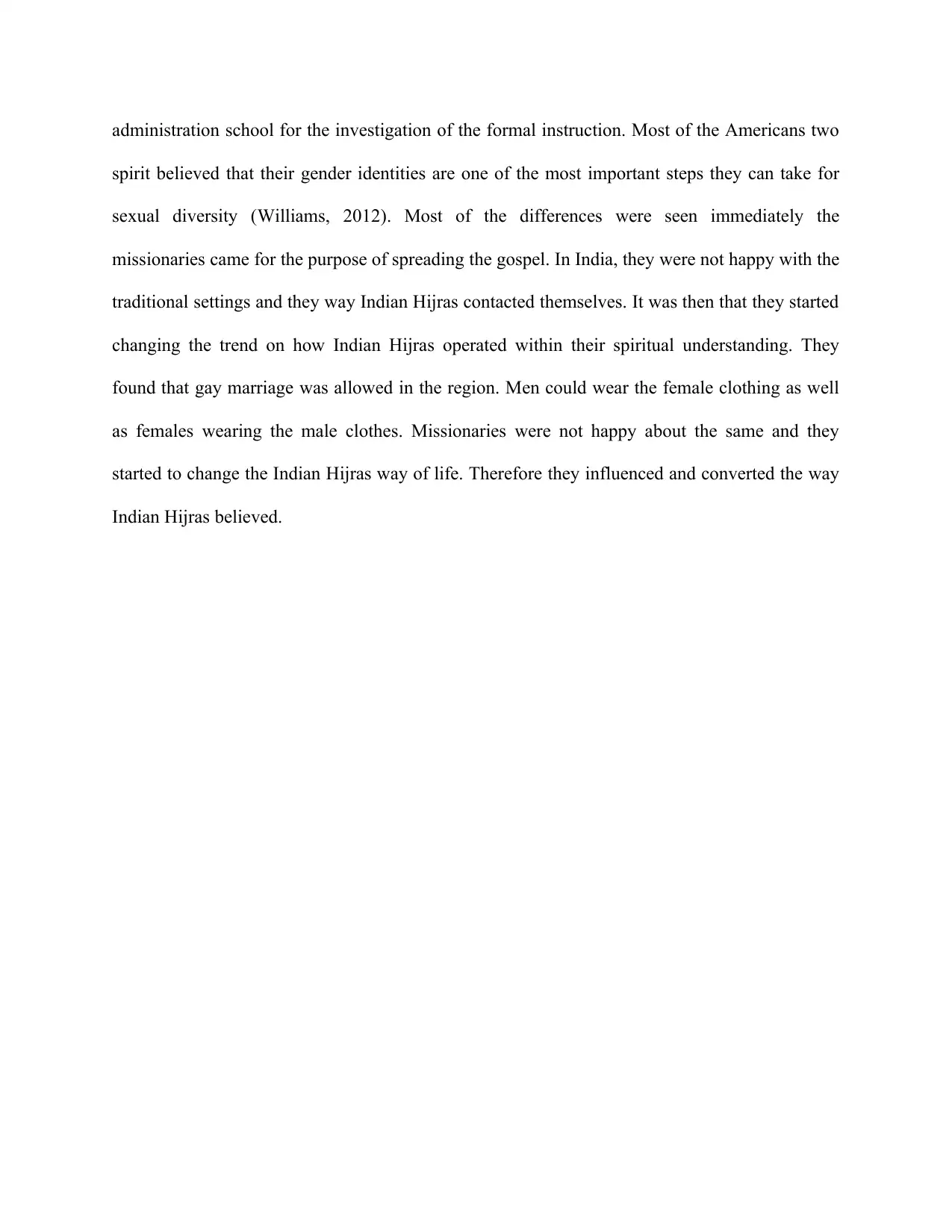
administration school for the investigation of the formal instruction. Most of the Americans two
spirit believed that their gender identities are one of the most important steps they can take for
sexual diversity (Williams, 2012). Most of the differences were seen immediately the
missionaries came for the purpose of spreading the gospel. In India, they were not happy with the
traditional settings and they way Indian Hijras contacted themselves. It was then that they started
changing the trend on how Indian Hijras operated within their spiritual understanding. They
found that gay marriage was allowed in the region. Men could wear the female clothing as well
as females wearing the male clothes. Missionaries were not happy about the same and they
started to change the Indian Hijras way of life. Therefore they influenced and converted the way
Indian Hijras believed.
spirit believed that their gender identities are one of the most important steps they can take for
sexual diversity (Williams, 2012). Most of the differences were seen immediately the
missionaries came for the purpose of spreading the gospel. In India, they were not happy with the
traditional settings and they way Indian Hijras contacted themselves. It was then that they started
changing the trend on how Indian Hijras operated within their spiritual understanding. They
found that gay marriage was allowed in the region. Men could wear the female clothing as well
as females wearing the male clothes. Missionaries were not happy about the same and they
started to change the Indian Hijras way of life. Therefore they influenced and converted the way
Indian Hijras believed.

References
Bolin, A. (2002). TRAVERSING GENDER Cultural context and gender practices. In Gender
Reversals and Gender Cultures. University of Australia Press pp. 36-65.
Castells, M. (2012). Population, cities, and the space of things to come. Tijdschrift voor
economische en sociale geografie, 93(5), p. 841-859
Herdt, G. (2011). Representations of homosexuality: An essay on cultural ontology and
historical comparison part i. Journal of the History of Sexuality, 1(3), 481-504.
Kogan, T. S. (2016). Transsexuals and Critical Gender Theory: The Possibility of a Restroom
Labeled Other. Hastings LJ, 48, 1223.
Lang, C., & Kuhnle, U. (2008). Intersexuality and alternative gender categories in non-Western
cultures. Hormone Research in Paediatrics, 69(4), 240-250.
Lang, S. (2018). Men as women, women as men: Changing gender in Native American cultures.
University of Texas Press.87-98.
Pavlenko, A. (2011). Bilingualism, gender, and ideology. International Journal of
Bilingualism, 5(2), 117-151.
Peoples, J., & Bailey, G. (2011). Humanity: An introduction to cultural anthropology. Cengage
Learning. 5(6), 89-123.
Sahastrabuddhe, S., Gupta, A., Stuart, E., Godbole, S., Ghate, M., Sahay, S., ... & Mehendale, S.
M. (2012). Sexually transmitted infections and risk behaviors among transgender persons
(Hijras) of Pune, India. JAIDS Journal of Acquired Immune Deficiency
Syndromes, 59(1), 72-78.
Bolin, A. (2002). TRAVERSING GENDER Cultural context and gender practices. In Gender
Reversals and Gender Cultures. University of Australia Press pp. 36-65.
Castells, M. (2012). Population, cities, and the space of things to come. Tijdschrift voor
economische en sociale geografie, 93(5), p. 841-859
Herdt, G. (2011). Representations of homosexuality: An essay on cultural ontology and
historical comparison part i. Journal of the History of Sexuality, 1(3), 481-504.
Kogan, T. S. (2016). Transsexuals and Critical Gender Theory: The Possibility of a Restroom
Labeled Other. Hastings LJ, 48, 1223.
Lang, C., & Kuhnle, U. (2008). Intersexuality and alternative gender categories in non-Western
cultures. Hormone Research in Paediatrics, 69(4), 240-250.
Lang, S. (2018). Men as women, women as men: Changing gender in Native American cultures.
University of Texas Press.87-98.
Pavlenko, A. (2011). Bilingualism, gender, and ideology. International Journal of
Bilingualism, 5(2), 117-151.
Peoples, J., & Bailey, G. (2011). Humanity: An introduction to cultural anthropology. Cengage
Learning. 5(6), 89-123.
Sahastrabuddhe, S., Gupta, A., Stuart, E., Godbole, S., Ghate, M., Sahay, S., ... & Mehendale, S.
M. (2012). Sexually transmitted infections and risk behaviors among transgender persons
(Hijras) of Pune, India. JAIDS Journal of Acquired Immune Deficiency
Syndromes, 59(1), 72-78.
Paraphrase This Document
Need a fresh take? Get an instant paraphrase of this document with our AI Paraphraser
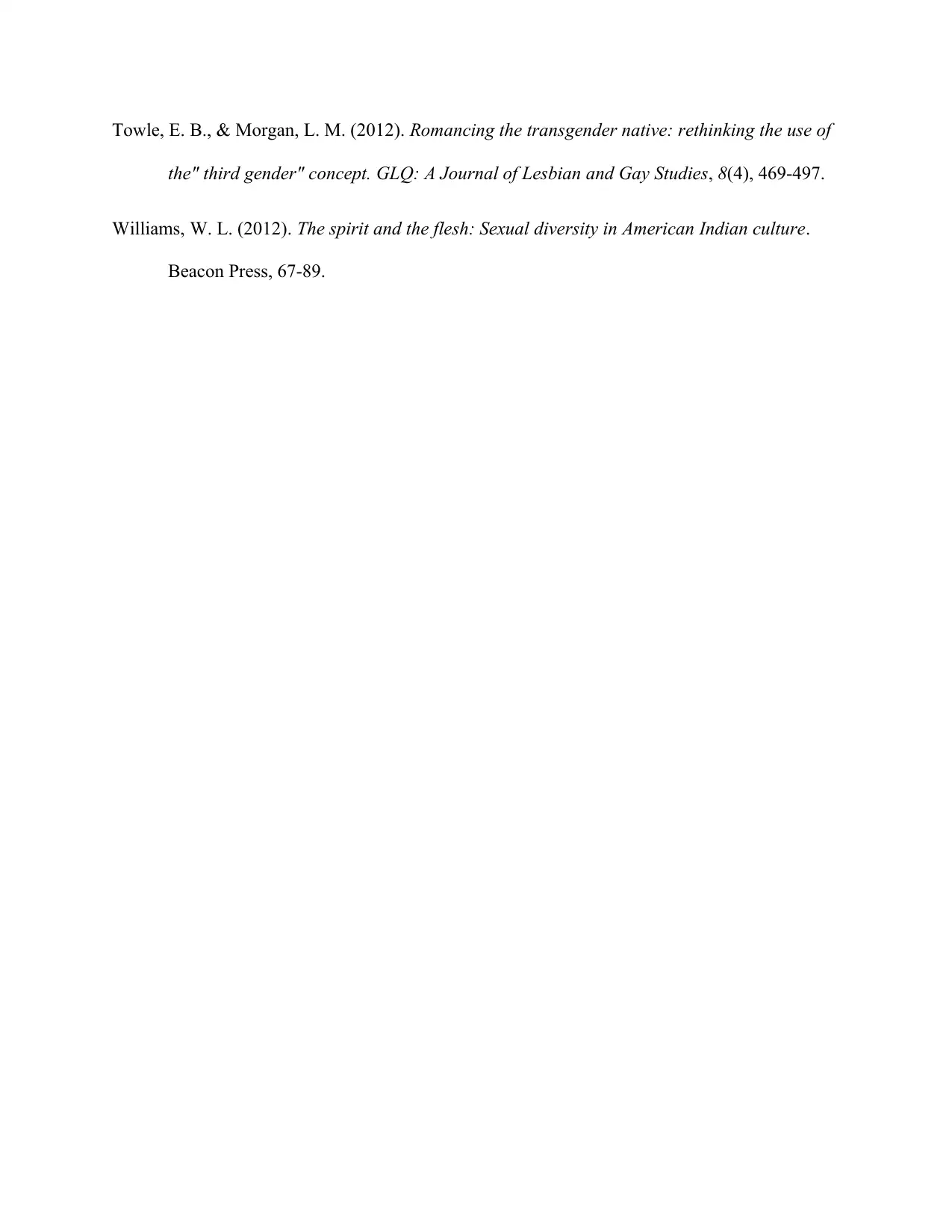
Towle, E. B., & Morgan, L. M. (2012). Romancing the transgender native: rethinking the use of
the" third gender" concept. GLQ: A Journal of Lesbian and Gay Studies, 8(4), 469-497.
Williams, W. L. (2012). The spirit and the flesh: Sexual diversity in American Indian culture.
Beacon Press, 67-89.
the" third gender" concept. GLQ: A Journal of Lesbian and Gay Studies, 8(4), 469-497.
Williams, W. L. (2012). The spirit and the flesh: Sexual diversity in American Indian culture.
Beacon Press, 67-89.
1 out of 8
Related Documents
Your All-in-One AI-Powered Toolkit for Academic Success.
+13062052269
info@desklib.com
Available 24*7 on WhatsApp / Email
![[object Object]](/_next/static/media/star-bottom.7253800d.svg)
Unlock your academic potential
© 2024 | Zucol Services PVT LTD | All rights reserved.





